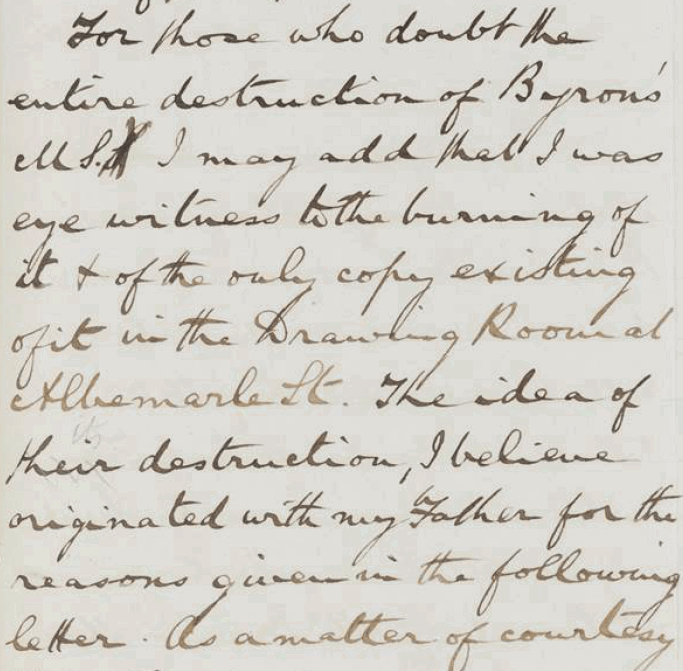"Everlasting infamy": the burning of Lord Byron's memoirs
Nineteenth Century Literary Society: The John Murray Publishing Archive charts the growth of the famous John Murray publishing house through the correspondence, accounts and written work of the literary luminaries who worked with the firm for almost 150 years of its history.
One such was the poet and aristocrat, Lord Byron, and among the highlights of the resource is the Byron Papers, the largest surviving collection of his writings, personal papers and correspondence.
Yet perhaps the most intriguing document related to the poet, famously described during his lifetime as “mad, bad and dangerous to know”, is one that cannot be found in Nineteenth Century Literary Society or, indeed, anywhere else. On 17 May 1824, in what has been called the greatest crime in literary history, the manuscripts of Lord Byron’s memoirs were destroyed in the fireplace of 50 Albemarle Street, the offices of Byron’s publisher, John Murray, by a group of his friends and family.

The burning of Byron's memoirs as reported in the Morning Chronicle, 20 May 1824. Image © National Library of Scotland. Further reproduction is prohibited without permission.
The perpetrators of this drastic act included Byron’s widow; his half-sister, Augusta Leigh; his publisher, John Murray II (his young son, John Murray III, was also present); and his great friend, the writer John Cam Hobhouse. Also present was Thomas Moore, the poet to whom Byron had entrusted his memoirs with instructions that they were not to be published during his lifetime, but “when I am cold – you may do what you please”.
Tantalisingly, while Moore respected this, he was not dissuaded from sharing the manuscript of the memoirs with friends, handing it out so many times that he had a copy made to stop the original from falling apart through overuse. While both the original and the copy were destroyed, Byron’s memoirs would have been read by some of the most well-known writers and readers of the early nineteenth century, including Washington Irving and Mary Shelley.
Surviving comments recorded on the manuscript’s contents were varied: while his former lover, Lady Caroline Lamb, commented in a letter that they were “of no value – a mere copy-book”, Byron himself told Thomas Medwin that he considered them to be “very entertaining and very instructive”. William Gifford, an editor working for Murray, considered that “the whole Memoirs were fit only for a brothel and would damn Lord B. to everlasting infamy if published”.
A heated debate over what to do with the poet’s unpublished memoirs raged for days, with Murray and Hobhouse arguing most strongly for their destruction. Although originally strongly opposed, Moore was eventually persuaded to agree by the arguments of the others, who feared that their publication would devastate Byron’s legacy (to say nothing of the good names of those who were mentioned!).

John Murray III recalls the burning of the memoirs in his father's offices. Image © National Library of Scotland. Further reproduction is prohibited without permission.
In the years that followed, much of the blame for the destruction of the memoirs was laid on Thomas Moore, who appears to have been the victim of a smear campaign at the hands of Hobhouse, with support from others. To modern scholarship, however, Hobhouse himself appears chiefly responsible.
Perhaps conscious of a need to defend his actions, he assembled a collection of assorted correspondence and clippings surrounding the events of the 17th of May, including the views of others. The extracts contained in this document variously portray the memoirs as either not being noteworthy of reading at all, or utterly deleterious to Byron’s name and legacy.
Whoever is ultimately responsible, the burning of Byron’s memoirs – and the loss of whatever they revealed about one of the first modern celebrities – has haunted scholarship ever since.
Nineteenth Century Literary Society: The John Murray Publishing Archive is out now. For more information on this resource, including free trial access and price enquiries, please email us at info@amdigital.co.uk.
Recent posts

The blog highlights American Committee on Africa, module II's rich documentation of anti-apartheid activism, focusing on the National Peace Accord, global solidarity, and student-led divestment campaigns. It explores the pivotal role of universities, protests, and public education in pressuring institutions to divest from apartheid, shaping global attitudes toward social justice and reform.

This blog examines how primary sources can be used to trace the impact of young voices on society, particularly during pivotal voting reforms in the UK and the US. Explore materials that reveal insights into youth activism, intergenerational gaps, and societal perceptions, highlighting their interdisciplinary value for studying youth culture, activism, and girlhood across history.
